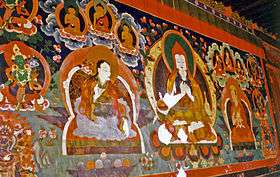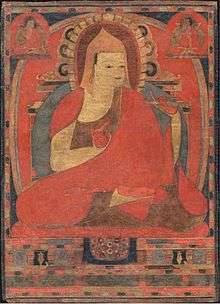Atiśa
| His Holiness Atiśa Dīpaṃkara Śrījñāna | |
|---|---|
|
This distinctive portrait of Atiśa originated from a Kadam monastery in Tibet and was gifted to the Metropolitan Museum of Art, New York in 1933 by The Kronos Collections. In this graphic depiction, Atiśa holds a long, thin palm-leaf manuscript with his left hand, which probably symbolizes one of the many important texts he wrote, and he makes the gesture of teaching with his right hand.[1] | |
| Born |
980 Bengal, Pala Empire |
| Died |
1054 Nyêtang, Tibet (now in China) |
| Occupation | Buddhist teacher |
| Known for | The major figure in the establishment of the Sarma lineages in Tibet. |
| Part of a series on |
| Buddhism |
|---|
 |
|
| Part of a series on |
| Tibetan Buddhism |
|---|
 |
|
Practices and attainment |
|
History and overview |
|
Atīśa Dīpaṃkara Śrījñāna (Bengali: অতীশ দীপংকর শ্রীজ্ঞান; Standard Tibetan: ཇོ་བོ་རྗོ།; Chinese: 燃燈吉祥智; pinyin: Rándēng Jíxiángzhì) (982 - 1054 CE) was a Buddhist Bengali religious leader and master.[2] He was one of the major figures in the spread of 11th-century Mahayana and Vajrayana Buddhism in Asia and inspired Buddhist thought from Tibet to Sumatra. He is recognised as one of the greatest figures of classical Buddhism, and Atisa's chief disciple Dromtön was the founder of the Kadam School.[3] Atisa is also considered to be a key figure in the establishment of the Sarma schools of Tibetan Buddhism.
Early life
Palace life
Bikrampur, the most probable place for Atiśa's birthplace, was the capital of the Pala Empire as it had been of the ancient kingdoms of southeast Bengal. Though the city's exact location is not certain, it presently lies in the Munshiganj District of Bangladesh, and continues to be celebrated as an early center of Buddhist cultural, academic, and political life. Similar to Gautama Buddha, Atiśa was born into royalty.[4] His father was a king known as Kalyana Shri and his mother was Shri Prabhavati. One of three royal brothers, Atiśa went by the name of Candragarbha during the first part of his life. In fact, it was not until he traveled to Guge and encountered King Jangchup Ö (Wylie: byang chub 'od , 984–1078) that he was given the name Atiśa.
Studies
According to Tibetan sources, Atiśa was ordained into the Mahāsāṃghika lineage at the age of twenty-eight by the Abbot Śīlarakṣita and studied almost all Buddhist and non-Buddhist schools of his time, including teachings from Vaishnavism, Shaivism, Tantric Hinduism and other practices. He also studied the sixty-four kinds of art, the art of music and the art of logic and accomplished these studies until the age of twenty-two. Among the many Buddhist lineages he studied, practiced and transmitted the three main lineages were the Lineage of the Profound Action transmitted by Asaṅga and Vasubandhu, the Lineage of Profound View transmitted by Nagarjuna and Candrakīrti, and the Lineage of Profound Experience transmitted by Tilopa and Naropa.[5] It is said that Atiśa had more than 150 teachers, but one key one was Dharmakīrtiśrī.[6]
Preaching in Sumatra and Tibet

Tibetan sources assert that Atisa spent 12 years in Sumatra and he returned to India in 1025 CE which was also the same year when Rajendra Chola I of the Chola dynasty invaded Sumatra.[7] Atiśa returned to India. Once back, the increasingly knowledgeable monk received much attention for his teachings and skills in debate and philosophy. On three separate occasions, the monk Atiśa was acclaimed for defeating non-Buddhist extremists in debate. When he came into contact with what he perceived to be a misled or deteriorating form of Buddhism he would quickly and effectively implement reforms. Soon enough he was appointed to the position of steward, or abbot, at Vikramashila established by Emperor Dharmapala.
Atiśa's return from Suvarnabhumi, where he had been studying with Dharmakīrtiśrī, and his rise to prominence in India coincided with a flourishing of Buddhist culture and the practice of Buddhism in the region, and in many ways Atiśa's influence contributed to these developments. According to traditional narratives, King Langdarma had suppressed Buddhism's teachings and persecuted its followers for over seventy years. According to the Blue Annals, a new king of Guge by the name of Yeshe-Ö sent his academic followers to learn and translate some of the Sanskrit Buddhist texts.[8] Among these academics was Nagtso, who was eventually sent to Vikramashila to study Sanskrit and plead with Atiśa to come teach the Dharma in his homeland. At Ngari, he was very impressed with the king's request for "a teaching of the people […] had [Atiśa] been asked for advanced empowerments into tantric deity systems […] he would have been far less pleased". It was during the three years Atiśa spent in this town that he compiled his teachings into his most influential scholarly work, Bodhipathapradīpa, and encountered the disciple forecast by Tārā, Dromtön. It was this disciple who furthered Atiśa's work after he died.
According to Jamgon Kongtrul, when Atiśa discovered the store of Sanskrit texts at Pekar Kordzoling, the library of Samye, "he said that the degree to which the Vajrayana had spread in Tibet was unparalleled, even in India. After saying this, he reverently folded his hands and praised the great dharma kings, translators, and panditas of the previous centuries."[9]
Writings
Following are his most notable books:
- Bodhipathapradīpa (Wylie: byang chub lam gyi sgron ma )
- Bodhipathapradhipapanjikanama (his own commentary of Wylie: byang chub lam gyi sgron ma )
- Charyasamgrahapradipa contains some kirtan verses composed by Atiśa.
- Satyadvayavatara
- Bodhisattvamanyavali
- Madhyamakaratnapradipa
- Mahayanapathasadhanasangraha
- Shiksasamuccaya Abhisamya
- Prajnaparamitapindarthapradipa
- Ekavirasadhana
- Vimalaratnalekha, a Sanskrit letter to Nayapala, king of Magadha.
See also
References
- ↑ "Portrait of Atiśa [Tibet (a Kadampa monastery)] (1993.479)". Timeline of Art History. New York: The Metropolitan Museum of Art, 2000–. October 2006. Retrieved 2008-01-11.
- ↑ "Reincarnation". Dalailama. The Dalai Lama. Retrieved 20 May 2015.
- ↑ POV. "Tibetan Buddhism from A to Z - My Reincarnation - POV - PBS".
- ↑ Maha Bodhi Society, The Maha Bodhi, Volume 90, p. 238.
- ↑ Great Kagyu Masters: The Golden Lineage Treasury by Khenpo Konchog Gyaltsen, Snow Lion Publications, pages 154-186
- ↑ Buswell 2014, p. 247.
- ↑ Atisa and Tibet: Life and Works of Dipamkara Srijnana by Alaka Chattopadhyaya p.91
- ↑ bstan pa'i mgon po (1974). Blue Annals. Lokesh Chandra.
- ↑ Tulku & Helm 2006, p. 74.
Bibliography
- Buswell, Robert Jr. (2014). Princeton Dictionary of Buddhism. Princeton, NJ: Princeton University Press. ISBN 9780691157863.
- Khenpo Konchog Gyaltsen, Great Kagyu Masters: The Golden Lineage Treasury, Snow Lion Publications
- Geshe Sonam Rinchen, Atiśa's Lamp for the Path to Enlightenment, Snow Lion Publications
- Khyentse, Dilgo (1993). 'Enlightened Courage. Ithaca, New York: Snow Lion Publications. ISBN 1-55939-023-9.
- Tulku, Ringu; Helm, Ann (2006). The Ri-Me Philosophy of Jamgon Kongtrul the Great: A Study of the Buddhist Lineages of Tibet. Boston: Shambhala Publications. ISBN 1-59030-286-9.
External links
| Wikimedia Commons has media related to Atisha. |
- Bibliography of Atisha's works, Item 596, Karl Potter, University of Washington
- Advice from Atiśa's Heart
- Atiśa Dipamkara on Banglapedia
- English Translation of Lamp to the Path of Enlightenment (by Dr. Alexander Berzin)
